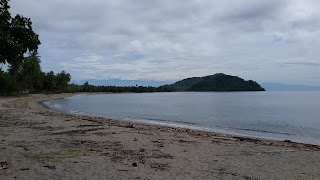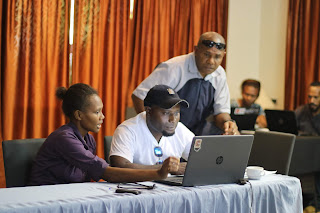THE RISING SEA AND THE FADING COASTLINE - SALAMAUA
One Particular area in Morobe province that has a remarkable war history and a natural harbour played an important role during World War II.
The German’s called it Samoahafen situated on the north-eastern coastline of Morobe province.
The settlement was built on a minor isthmus between the coast with mountains on the inland side and a headland.
Today the coastline of these places face one of the biggest threats from the forces of nature. It has being a growing concern among the people. The issue of Sea level rise has done so much damage, that the people in this area see to it every day.
Just 45 minutes out of Lae is Salamaua. Surrounded by white stretch of sandy beach, evergreen lush vegetation and incredible views.
It used to be a town then before the war. The Japanese captured the place on 8 March 1942 during World War II. It was later retaken by Australian and United States forces led by General Douglas MacArthur on 11 September 1943 during the Salamaua-Lae campaign.
During reoccupation the town was destroyed. The remains of what it used to be is visible when you take a hike around the place.
Today the villages of Kela and Laugui occupy the site as well as holiday houses, mainly for expatriates and business houses based in Lae.
The white stretch of sandy beach extends two kilometers from one point to another. This has been a major picnic area for the Lae residents.
But amidst its incredible views and magnificent environment lays one major problem that is gradually eating away their land. People often say climate change is a disaster but for this one_ you see it happening everyday right in front of you.
‘’It has become part of our lives now. It’s an everyday phenomena were we try to live our lives around it as we watch it steal the remaining resources we have’’, explained a retired teacher.
Its peaceful quiet and laid back surroundings have become one of the worse hit areas in the country among the forces of nature. It has no respect for the dead and or their resting place.
‘’Storm surges causing king tides have washed out resting places of our loved ones. It is fully exposed. Some parts of it is already under the sea.’’
The Retired teacher talking to the Author.
The retired primary school teacher further explained to us that this issue has being affecting them and their way of life.
‘’During my time, in the 70s there was nothing of this sort. There was land further out there. A lot of trees and we had our primary school there. We used to have a good supply of fresh water here. It’s quite different now. You could only wonder, how all this happened?’’.
Despite the obvious, life has to go on for the Laugui, Kela and the surrounding villages. The rising sea level is causing the land to gradually submerge.
‘’ We are moving to higher grounds to make gardens. The changing of weather patterns has affected our fruit trees and our flowering plants. Things are happening out of season’’.
Salt water intrusion is causing dropping limits of clean groundwater levels and loss of freshwater, particularly in Laugui, which poses a challenge for innovative agricultural expansion.
‘’Fresh drinking water has been a problem. The continuous high tides has affected our ground water. We carry our container and travel long distance to get water from the big river on the other side’’, he further reiterated.
Maria Tamudu, a Women leader adds that irregular rainfall patterns with periods of prolonged dry seasons have affected soil fertility and yield.
It has increased the spread of infectious diseases and pests, which are further decreasing agricultural productivity resulting in shortage of food.
“The things we are seeing now has never happened before. Some times our gardens are destroyed because there’s more rain than expected. Other times, we have drought. The sea is eating away our land. Some areas that used be trees growing are now under water’’.
But the people are resilient. They work together to protect their boundaries from the rising sea level. Most of them living here are refusing to leave and continue to live at the front line of climate change.''
“The people are adapting to the conditions that are been forced upon them. We have been building buffer zones and assisting in any way we can to avoid storm surges. Sometimes we just watch as the sea take away whatever that is there right before our eyes.’’
Despite the odds community participation is highly regarded among the people and has improved their lifestyles.
Salamaua LLG Manager, Yambeng Kwafenuc says, Although International Organisation for Migration has briefly carried out awareness and educational programs in the affected areas, a collaborative effort is needed to strengthen and educate the people on this cross-cutting issue.
It’s important we educate ourselves and take responsibility. We can’t wait for miracle to happen or rely on our local leaders to give a helping hand. It’s good to see the communities are are rallying to together. I am delighted to see that kind of spirit.’’
Mr Kwafenuc
Kwafenuc added that funding is a problem especially with 17 wards. It can be very daunting and impact projects are not realised in most areas. LLGSIP has helped a bit to fix footbridge and other small projects
‘’This cross-cutting issue is not only affecting and changing people lives but has caused a lot of damage to the little infrastructure we have.’’
In the meantime an adaptation fund project initiative which focuses on enhancing adaptive capacity for communities to combat climate change related issues is extended for another year.
The key objective of this project is to reduce vulnerability of communities to coastal and in land flooding as well as improve government’s institutional and human capacity to address climate change impacts in the country.
With 9 priority areas in the Adaptation project, the Climate Change and Development Authority has started conducting vulnerability assessment on the impacts of climate change and natural disasters to identify potential risks. Morobe province was one of the pilot areas.
END!!
Note: This story was first published in 2016 on NBCTV. Some of the content in this story might have changed then.












Comments
Post a Comment